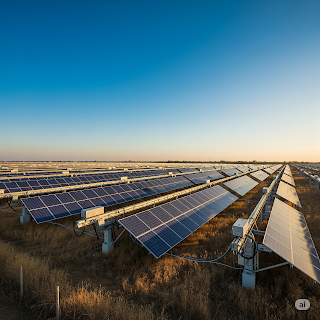📦 Key Takeaways
-
🔄 Solar trackers increase energy output by 15%–45% compared to fixed-tilt systems.
-
📈 They adjust panel orientation in real-time to follow the sun’s path.
-
🛠️ Types include single-axis and dual-axis trackers.
-
🌍 Widely used in utility-scale projects, especially in India’s solar parks.
-
💰 Higher upfront cost, but faster return on investment (ROI) due to higher efficiency.
-
🔋 Crucial for maximizing land use and meeting clean energy targets.
As the world races toward renewable energy, solar power has emerged as a front-runner. However, installing solar panels isn’t enough. To truly harness the sun’s full potential, we need to maximize the amount of sunlight hitting those panels throughout the day. That’s where solar trackers come in.
📌 What Are Solar Trackers?
Solar trackers are mechanical systems that adjust the position of solar panels so that they continually face the sun as it moves across the sky. By doing so, they optimize energy capture, improving the efficiency and output of solar power systems.
Think of them as GPS-guided rotators for solar panels—keeping the panels pointed directly at the sun throughout the day for maximum energy absorption.
📊 Why Do Solar Trackers Matter?
Without trackers, solar panels only perform optimally during peak sun hours. Trackers eliminate this limitation by ensuring that panels receive direct sunlight all day, leading to:
-
Higher energy yields
-
Reduced levelized cost of electricity (LCOE)
-
Better ROI for large-scale solar farms
-
Optimal land utilization in dense or limited-space installations
⚙️ Types of Solar Trackers
1. Single-Axis Trackers
-
Rotate on one axis—usually from east to west.
-
Most commonly used due to cost-effectiveness and simplicity.
-
Provide a 20%–30% increase in energy generation.
2. Dual-Axis Trackers
-
Rotate on both horizontal and vertical axes.
-
Follow the sun in a more precise, circular pattern.
-
Ideal for locations with varying sunlight angles or higher latitudes.
-
Deliver 30%–45% more energy, but costlier and more complex.
📍 Real-World Applications
India, aiming to install 500 GW of renewable capacity by 2030, is increasingly deploying solar trackers in its mega solar parks like Pavagada (Karnataka) and Bhadla (Rajasthan). Companies like Nextracker and Array Technologies have already deployed gigawatts worth of tracking systems in India to improve reliability and efficiency.
💡 Benefits vs. Challenges
| Benefits | Challenges |
|---|---|
| 15%–45% more energy output | Higher upfront and maintenance costs |
| Better land efficiency | Requires flat, open land |
| Ideal for large-scale setups | Sensitive to high winds/mechanical issues |
| Improved ROI in 3–5 years | Needs expert installation |
🧪 Scientific Validation
Several studies confirm that trackers drastically improve output. A 2023 study in Renewable Energy Journal found that single-axis trackers could increase output by 25% in India’s semi-arid regions. Over a plant's 25-year lifespan, this results in millions of kilowatt-hours in additional power.
🌱 Sustainability Angle
By increasing the power generated per panel, solar trackers help:
-
Reduce the total number of panels needed.
-
Minimize resource use (land, silicon, wiring).
-
Accelerate the transition toward a low-carbon grid.
🏁 Conclusion: Why Solar Trackers Are Worth It
While solar trackers may seem like an optional upgrade, they are in fact critical for large-scale, high-efficiency solar projects. Especially for countries like India, where land and sunlight are abundant but energy needs are massive, trackers are the smart choice to optimize both space and output.
As the demand for renewable energy grows, expect to see more solar installations that don’t just sit there—but move with the sun.

No comments:
Post a Comment